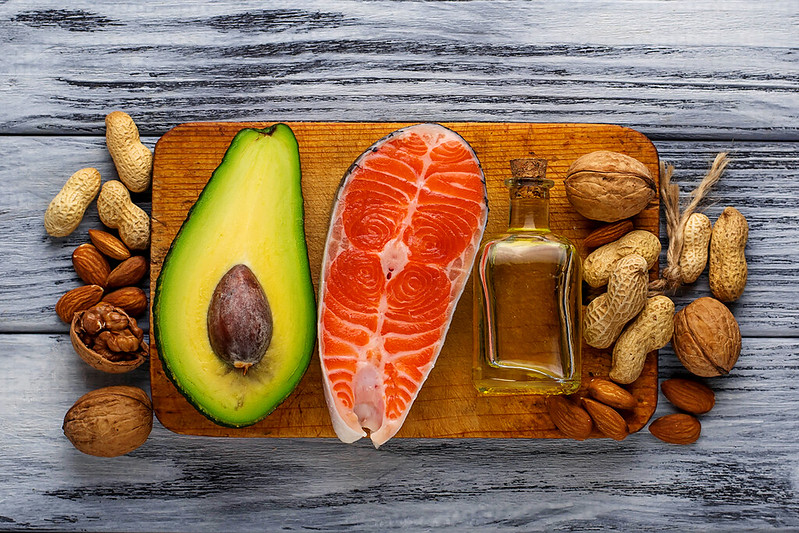-
Omega-3 Fatty Acids – Understanding these Essential Fats
Omega-3 Fatty Acids are essential and incredibly important for your body and brain. They are essential because they MUST be obtained through our diet. Read on for science-based health benefits of omega-3s, why they are so important and everything else you need to know.
At this point, you know how I feel about fats and the importance of including quality fats in our diet. Today we are going to talk more specifically about essential fatty acids. The two most well-known polyunsaturated fats are omega-3s and omega-6s. Both are considered to be essential fatty acids, because our body needs them and we cannot produce them on our own. It is important that we get these essential fats from our food. The human body can create most of the types of fats it needs from other fats or raw materials, but for these essential fatty acids, this isn’t the case.
Since we’ll be talking almost exclusively about omega-3s in this post, I do want to quickly first address about the “other” EFA. The essential fatty acid, linoleic acid (LA) is an inflammatory omega-6 fat. While that word “inflammatory” may sound bad to you, this is your reminder (we’ve talked about it before), that inflammation is quite important in our body, as part of proper healing. For example, you whack your head and get a swollen goose egg, that little bump is just one example of inflammation and it’s actually quite important to the healing process, as the inflammation sends nutrients and blood flow to that area for it to heal. Adequate omega-6 fatty acids, make this inflammation possible. That said, an excess of omega-6 fatty acids, as you can imagine can promote chronic and excess inflammation, which we all know can promote a wide array of diseases.
While both omega-3s and 6s are essential to the body, due to our modern diets that tend to effortlessly be abundant in omega-6 fats, most people are severely deficient in omega-3 fatty acids, so the ratio is severely imbalanced for many. Let’s talk about how we can fix that and why it’s important.
Understanding EFAs and Why Omega-3 Is Most Coveted:
The omega-3 fatty acids were first discovered in the early 1970’s when Danish physicians observed that Greenland Eskimos had an exceptionally low incidence of heart disease and arthritis despite the fact that they consumed a diet high in fat. These early studies established fish as a rich source of n-3 fatty acids.
EFAs are the good fats necessary for hormone production and they are important for normal growth, especially of the blood vessels and nerves and to keep the skin and other tissues looking youthful and supple as a result of their lubricating quality. Omega-3 fats are an integral part of cell membranes throughout the body and affect the function of the cell receptors in these membranes. They provide the starting point for making hormones that regulate blood clotting, contraction and relaxation of artery walls, and inflammation. They also bind to receptors in cells that regulate genetic function. Likely due to these effects, omega-3 fats have been shown to help prevent heart disease and stroke, may help control lupus, eczema, and rheumatoid arthritis, and may play protective roles in cancer and other conditions. 1https://www.hsph.harvard.edu/nutritionsource/what-should-you-eat/fats-and-cholesterol/types-of-fat/omega-3-fats/
In the typical America Diet it is far easier to get omega-6 EFAs (linoleic acid) than the omega-3 EFAs (alpha-linolenic acid). While omega-6 on it’s own from quality sources, isn’t a villain, for most people their excessive omega-6 consumption is coming from non-whole food sources like highly refined plant and seed oils (including corn, canola, safflower, sunflower and, soybean oils), which we already know to be toxic, food-like-substances we are best to avoid. These are the oils most typically found in restaurants, fast foods and other foods of convenience, like packaged, processed foods. Most folks are getting hit with omega-6 fatty acids from many places, while simultaneously not consuming enough omega-3 fatty acids. Other sources of omega-6 fats are grains, legumes, nuts, seeds, poultry (even the organically grown) and industrially raised meat. So it makes sense that adequate (if not far more than) levels of omega-3 fats are effortlessly consumed.
- The human body does best with a ratio of omega-3 to omega-6 fats somewhere in the range or 1:1 to 1:4. Unfortunately most Americans are existing in a ratio upwards of around 1:20, and many have NO detectable level of omega-3 fats, at all.
- Balancing this ratio takes special care to reduce the amount of highly-refined, non-nutrient dense, omega-6 abundant foods in our diet (processed foods, fried foods, fast food, vegetable oils, etc) and consistently including more preformed omega-3 rich seafood (or algae).
- For what it’s worth, grass-fed meat contains 5 times the omega-3 fats as conventionally raised meat and lower levels of omega 6 fats. 2https://www.ncbi.nlm.nih.gov/pmc/articles/PMC2846864/ Grass fed beef’s ratio of of omega-3 to omega-6 is 1:1 where as the ratio in conventionally raised meat is more like 1:7.
Omega-3 Fatty Acids are Important:
- Omega-3 essential fatty acids reduce inflammation, promote cardiovascular health, protect your brain and help prevent metabolic syndrome and chronic diseases. 3https://www.ncbi.nlm.nih.gov/pubmed/23794360
- The human brain is primarily made up of fat and it has a high requirement for DHA, a type of omega-3 fatty acid. Low DHA levels have been linked to low brain serotonin levels, which are connected to an increased tendency for depression and suicide. Several studies have established a correlation between low levels of omega-3 fatty acids and depression. High consumption of omega-3 FAs is typically associated with a lower incidence of depression, a decreased prevalence of age-related memory loss and a lower risk of developing Alzheimer’s disease 4Kalmijn S. Dietary fat intake and the risk of incident dementia in the Rotterdam Study. Annals of Neurology. 1997;42(5):776–82. doi: 10.1002/ana.410420514. [PubMed] [Cross Ref] 5Yehuda S, Rabinovtz S, Carasso RL, Mostofsky DI. Essential fatty acids preparation (SR-3) improves Alzheimer’s patient’s quality of life. International Journal of Neuroscience. 1996;87(3-4):141–9. doi: 10.3109/00207459609070833. [PubMed] [Cross Ref] 6Hibbeln JR. Fish oil consumption and major depression. The Lancet. 1998;351:1213. doi: 10.1016/S0140-6736(05)79168-6. (April 18 1998) [PubMed] [Cross Ref] 7Hibbeln JR, Salem N. Dietary polyunsaturated fatty acids and depression: when cholesterol does not satisfy. American Journal of Clinical Nutrition. 1995;62:1–9. [PubMed] 8Stoll AL. Omega 3 fatty acids in bipolar disorder. Archives of General Psychiatry. 1999;56 407-12-415-16. [PubMed] 9Calabrese JR, Rapport DJ, Shleton MD. Fish oils and bipolar disorder. Archives of General Psychiatry. 1999;56:413–4. doi: 10.1001/archpsyc.56.5.413. [PubMed] [Cross Ref] 10Laugharne JDE. Fatty acids and schizophrenia. Lipids. 1996;31:S163–S165. doi: 10.1007/BF02637070. [PubMed] [Cross Ref]
- A lack of omega-3s can lead you to a higher risk of heart disease and chronic inflammation. Deficiency has also been linked to higher chances of dementia and alzheimers, ADD, arthritis, poor cognitive function and brain development, joint pain and more.
References
1. ↑ https://www.hsph.harvard.edu/nutritionsource/what-should-you-eat/fats-and-cholesterol/types-of-fat/omega-3-fats/ 2. ↑ https://www.ncbi.nlm.nih.gov/pmc/articles/PMC2846864/ 3. ↑ https://www.ncbi.nlm.nih.gov/pubmed/23794360 4. ↑ Kalmijn S. Dietary fat intake and the risk of incident dementia in the Rotterdam Study. Annals of Neurology. 1997;42(5):776–82. doi: 10.1002/ana.410420514. [PubMed] [Cross Ref] 5. ↑ Yehuda S, Rabinovtz S, Carasso RL, Mostofsky DI. Essential fatty acids preparation (SR-3) improves Alzheimer’s patient’s quality of life. International Journal of Neuroscience. 1996;87(3-4):141–9. doi: 10.3109/00207459609070833. [PubMed] [Cross Ref] 6. ↑ Hibbeln JR. Fish oil consumption and major depression. The Lancet. 1998;351:1213. doi: 10.1016/S0140-6736(05)79168-6. (April 18 1998) [PubMed] [Cross Ref] 7. ↑ Hibbeln JR, Salem N. Dietary polyunsaturated fatty acids and depression: when cholesterol does not satisfy. American Journal of Clinical Nutrition. 1995;62:1–9. [PubMed] 8. ↑ Stoll AL. Omega 3 fatty acids in bipolar disorder. Archives of General Psychiatry. 1999;56 407-12-415-16. [PubMed] 9. ↑ Calabrese JR, Rapport DJ, Shleton MD. Fish oils and bipolar disorder. Archives of General Psychiatry. 1999;56:413–4. doi: 10.1001/archpsyc.56.5.413. [PubMed] [Cross Ref] 10. ↑ Laugharne JDE. Fatty acids and schizophrenia. Lipids. 1996;31:S163–S165. doi: 10.1007/BF02637070. [PubMed] [Cross Ref] -
Happy Hormones: The Importance of Digestion to Hormone Balance
This is the third Happy Hormones post in our Hormone-Focused Series from Nutritional Therapy Practitioner Brynn D’Avello. I suggest reading the first post The First Step to Happy Hormones and then the second post where we tackle how Blood Sugar Imbalance Affects Your Hormones before you dive into this post covering the Importance of Digestion to Hormone Balance.
As we discussed in the previous post in this series, as important and crucial as blood sugar regulation is to hormone balance in this latest installment we will discuss how digestion is a very, very close second. Since I know Beth has done a killer job breaking down the digestive process in her Digestion 101 series I am only going to touch on the highlights…. with a very special emphasis on the liver.
Digestion is a North-to-South Process, and to help strengthen it effectively we must naturally start at the top and work our way down. Most of us would assume that the first step to digestion is in the mouth, but you actually have to go a little bit higher than that. The brain. To activate salivary enzymes your brain must be engaged. That’s why your mouth waters when you smell something delicious. It’s getting the signal that food is coming its way, and saliva, in addition to chewing thoroughly, helps start the breakdown of food into useable nutrients. (You can read more here about the roles that our brain and mouth play in digestion) Once our food gets to the stomach, gastric juices go to work on proteins and then it gets passed on to the small intestine. Here is where the gallbladder kicks in. Bile is secreted to emulsify the fats in our food to assimilate the necessary elements, to be used effectively. Without good quality bile, fats are not digested properly. Fats are absolutely critical to the entire endocrine system. Our body cannot produce hormones without fats.









